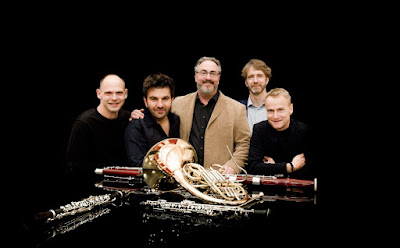Ensemble 4.1 soars on winds of chamber-music change
Oboist Joerg Schneider crossed the stage between pieces to inform his colleague and Ensemble 4.1
 |
| Ensemble 4.1 engages in continual search to underscore its uniqueness. |
clarinetist Alexander Glucksmann that the "piano-windtet"'s engagement via the Ensemble Music Society Wednesday night was the group's 125th concert.
The German chamber-music group, with its unusual make-up of oboe-bassoon-horn-clarinet-piano, has a 10-year history with a lot of globetrotting experience under its belt, Glucksmann added in remarks to the Indiana History Center audience.
Statistics clearly are a point of pride to Ensemble 4.1, whose name reflects our digitized world where 2.0 signals a twice-as-good 1.0. Here it transparently signals the combination of four wind instrumentalists and one pianist: Thomas Hoppe, familiar as one of the International Violin Competition of Indianapolis' veteran assistants at the keyboard. He was plying that part of his trade in the same hall just last month.
Hoppe returned to the city to display another aspect of his artistry with this group, which also includes Sebastian Schindler, horn, and Christoph Knitt, bassoon. The musicians continually search for new material that fits their personnel. A fan of theirs, who Glucksmann says is regularly on the hunt, several years ago found N.H. Rice's Quintet in E-flat, op. 2, which occupied the middle position in Wednesday's concert.
Next to nothing is known about Rice, whose late-romantic style in this piece is all about charm and strikes the ear as close to salon music. The four-movement work was a novelty worth hearing, though the composer seems modestly capricious in how he combines the instruments. Much of the music explores balancing solo and duo passages with full-ensemble statements.
There's a lot of imitative writing to help tie Rice's inspirations together. The finale is irrepressibly upbeat, with lots of rising phrases making clear that simple delight is the best impression to leave with whatever audiences Rice may have been able to attract in his lifetime. Ensemble 4.1 comes to the rescue for his posterity by including the E-flat quintet in its repertoire.
To put Mozart's quintet for the same forces, also in E-flat (K. 452) in the program's first (instead of the scheduled third) place was a late inspiration, apparently. The switch worked well, because compositional facility is here joined to genius, and Ensemble 4.1 could strut its stuff. Mozart, in mature form here, lays out a slow first-movement introduction with suggestions of fanfare, and we know we are heading into the musical stratosphere. In the third movement, there are signs of the quasi-operatic writing Mozart applied to actual operas at the height of his career. Rice's salon-bound musings would just have to wait.
They were placed just after intermission to allow Mozart to command Ensemble 4.1's initial impression on Indianapolis. The double-reed players were particularly remarkable in the fullness and steadiness of their playing. Across from them, wearing distinctive white shoes, were the equally adept hornist and clarinetist. (The group's current group portrait, inserted above, appears to show a different horn player.) Ensemble 4.1 must have a thing for comfortable footwear, if what I could see of the others' is an indication.
Hoppe's warmth of personality came through in his playing throughout, and there was never any doubt as to how essential a simpatico pianist is to this combination's success. Tonal balance and pinpoint coordination were the norm. That was amply demonstrated in an amazing arrangement of George Gershwin's immortal "American in Paris," which concluded the program.
By dividing the material among solo instruments, each with its own character, Ensemble 4.1 confirmed Gershwin's genius. "An American in Paris" fits well on the symphonic pops programs where it often appears, but it is also worth deeply reveling in for its breadth of color, melody and infectious rhythms. All these aspects came through point by point in Ensemble 4.1's performance, which was rapturously greeted at the end. The band kept the fun level high in the encore, a bagatelle titled "Tempo di Beguine" (a dance form most Americans only know via the Cole Porter song) by the late 20th-century Swiss composer Hans Stähli.
Ensemble Music Society is off to a good start living up to its season slogan, "Altogether Brilliant."



Comments
Post a Comment